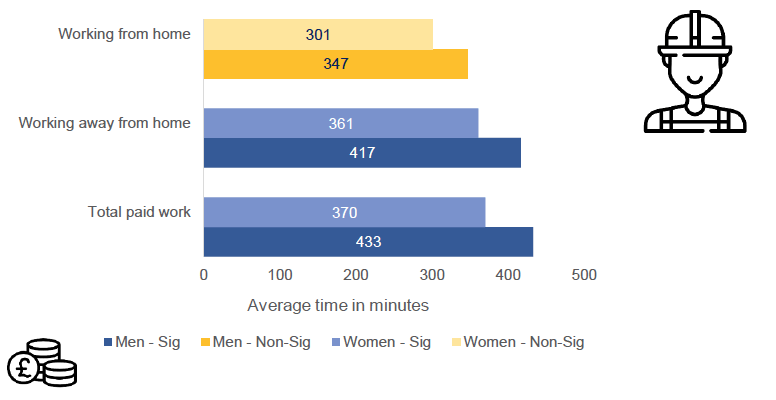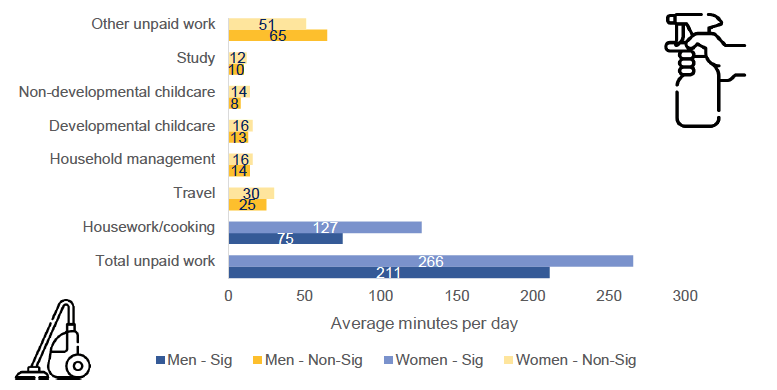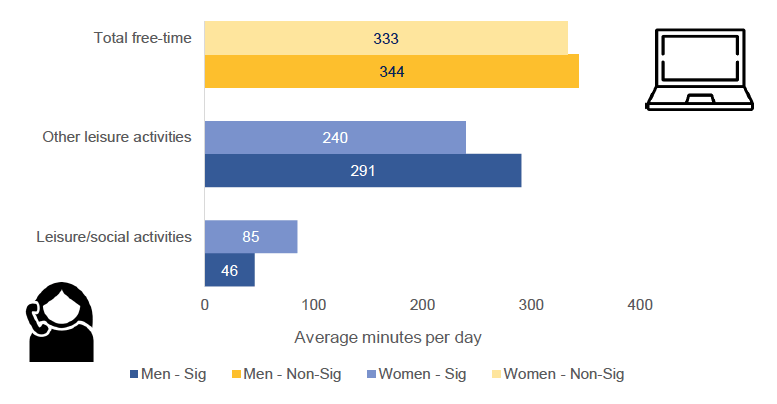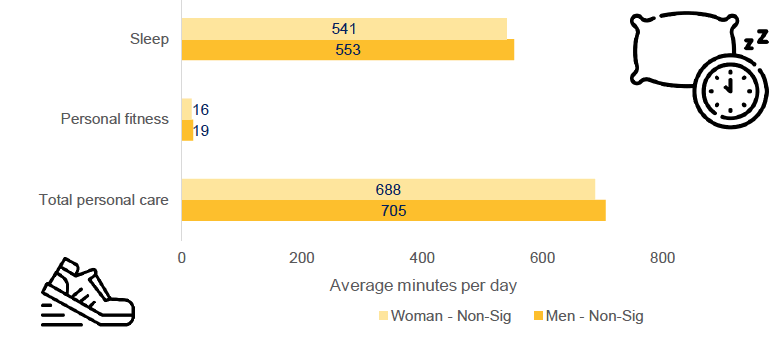Time use in Scotland 2020: ONS Online Time Use Survey - gender analysis
Looks at how time was used in Scotland in 2020 with a focus on gendered differences between women and men. This publication has been superseded by https://data.gov.scot/time-use-scotland/
3. Results
3.1 Paid work

* average time for respondents working on a given day, but not for the total sample
In 2020, of men and women who worked on a given day, men spent significantly more time than women in overall paid work, and specifically in work away from home. There was no significant difference between men and women in time spent in work from home.
Paid work is a combination of working away from home and working from home for monetary reward.
In 2020, the ways that paid work was carried out changed a lot as a result of the COVID-19 pandemic and the subsequent restrictions. Those who were able to work from home, and who usually work from offices, were asked to do so. While many others, including those working in bars and restaurants and in the retail sector, were placed on furlough. That is to say that their work places were closed, or capacity reduced, and they were placed on temporary paid leave. As a result, the 2020 OTUS may show lower average time spent on paid work across the whole sample than might be expected, and work taking place on a lower percentage of diary days.
In addition, it should also be noted that time use is averaged across the 7 day week, and as such average time use per day may appear lower than if it were averaged across a 5 day working week.
In 2020, the average time a person spent on paid work was 152 minutes (just over 2 hours 30 minutes) per day. Focusing on gender, men spent an average of 166 minutes (1 hour 46 minutes) per day on paid work, compared to 138 minutes (2 hours 18 minutes) for women. Paid work took place on 38% of diary days for men and 37% of diary days for women.
The above figure refers to the average time spent on paid work across the whole sample, some of whom do not participate in paid work. It may be more useful to consider only the proportion of the sample who worked on a given day. Amongst this group the average time spent on paid work was 402 minutes (6 hours 42 minutes) per day. Men who worked on a given day spent significantly more time on this activity – an average of 433 minutes (7 hours 13 minutes) per day - compared to women, who took part in paid work for an average of 370 minutes (6 hours 10 minutes) a day.
Working away from home
Working away from home includes working in locations outside of the home, such as undertaking delivery or taxi activities, working in a shop or restaurant or working in an office.
In 2020, the average time a person spent working away from home was 91 minutes (1 hour 31 minutes) per day. Men spent 103 minutes (1 hour 43 minutes) a day working away from home, while women worked away from home for 79 minutes (1 hour 19 minutes) a day. This difference was not significant. Paid work away from home took place on 25% of diary days for men, and 22% of diary days for women.
Amongst only those who took part in paid work away from home, the average time spent on this activity was 391 minutes (6 hours 29 minutes) a day). Men spent significantly more time working away from home than women – an average of 417 minutes (just under 7 hours) per day compared to 361 minutes (6 hours) per day for women.
Working from home
Working from home includes working either from home or cafés (although working from cafés was not possible during the lockdown that was in place during wave one fieldwork), selling things online, or showing people around your home to sell it. In the context of the 2020 OTUS, it also includes people who would normally work from offices undertaking work from home, as was necessary for many during the COVID-19 lockdown and subsequently.
In 2020, the average time spent working from home amongst the total sample was 61 minutes per day. There was no significant difference in the amount of paid work from home carried out by men and women. On average men did 63 minutes of paid work from home per day, while women did 59 minutes per day. Paid work from home took place on 18% of diary days for men and 20% of diary days for women.
The average time spent on working from home amongst only those in the sample who took part in this activity was 323 minutes (5 hours 23 minutes) per day. Men spent slightly more time on paid work from home – an average of 347 minutes (5 hours 47 minutes) per day, compared to women who spent an average of 301 minutes (just over 5 hours) per day on paid work from home. These differences were not statistically significant.
3.2 Unpaid work

* these figures show average minutes for the whole sample
In 2020, women spent significantly more time than men on unpaid work overall and housework/cooking. There were no significant differences between men and women in time spent on travel; household management; developmental childcare; non-developmental childcare; study and other unpaid work.
Unpaid work is a combined variable, meaning that it incorporates a range of other activities which are also reported on separately within this study. The seven components of unpaid work are: housework/cooking; household management; developmental childcare; non-developmental childcare; travel; studying and other unpaid work. These activities are discussed individually in subsequent sections of this report.
Considering the combined variable of 'unpaid work', the average time a person spent on these activities was 238 minutes (3 hours 58 minutes) per day. Women did significantly more unpaid work than men. On average, per day, women spent 266 minutes (4 hours 26 minutes) on unpaid work, while men devoted 211 minutes (3 hours 31 minutes). 99% of diary days involved unpaid work for women, compared to 91% for men.
Housework/cooking
The 'housework/cooking' variable includes activities concerned with domestic work, for example: making food and drinks; cooking or washing up; cleaning, hoovering, tidying house; ironing, washing or mending clothes.
The average amount of time a person spent on housework/cooking in 2020 was 101 minutes (1 hour 41 minutes) per day. Women did significantly more housework/cooking than men. Women spent an average of 127 minutes (just over 2 hours) per day on these activities, compared to men who spent 75 minutes (1 hour 15 minutes) per day on housework/cooking. Housework/cooking took place on 93% of diary days for women, and 71% of diary days for men.
Travel
The 'travel' activity compromises of travel/ transport, e.g. walking, driving. It includes travel for leisure, such as going on holiday or day trips, and commuting to and from work.
In 2020, during the COVID-19 lockdown, travel was restricted to within a five mile radius of a person's place of residence. In addition, with many workers working from home or on furlough time spent on commuting was drastically reduced. These factors are likely to have had an impact on the average time spent on travel per day in 2020.
In 2020, the average amount of time spent on travel was 28 minutes per day. Women spent an average of 30 minutes per day on travel, compared to men who spent 25 minutes a day on this activity. These differences were not significant. Travel took place on 36% of diary days for women and 39% of diary days for men.
Household management
'Household management' as a variable combines the following activities: banking, errands, appointments and food and drink shopping.
The average amount of time a person spent on household management in 2020 was 15 minutes per day. There was no significant difference in the amount of time spent on household management between men and women. On average, per day, women spent 16 minutes on household management while men devoted 14 minutes to this activity. Household management took place on 26% of diary days for women and 22% of diary days for men.
Developmental childcare
'Developmental childcare' includes activities that influence physical, language, thought and emotional changes in children which help their development. Examples include: reading, playing with, or helping children with homework. In the 2020 OTUS developmental childcare could also include scenarios where it was the primary (or main) activity - the only activity taking place – or situations where developmental childcare was a secondary activity. For example, looking after the child while they, or you, are doing another activity.
Developmental childcare is particularly important to consider in the context of the 2020 OTUS because during the COVID-19 lockdown schools and nurseries were closed (except for those children whose parents are key workers). As a result many parents and carers were required to home school their children – a form of developmental childcare.
Considering the whole sample population in 2020, the average amount of time a person spent on developmental childcare was 14 minutes per day. There was no significant difference in the average amount of time per day that women and men spent on developmental childcare (16 minutes and 13 minutes respectively).
Given that the above figures refer to the whole sample, many of whom will not have children, it may be more useful to consider only the proportion of the sample who have children. This can be considered both in terms of situations where developmental childcare is the main activity taking place and where it is the secondary activity taking place.
The average time spent on developmental childcare as a main activity amongst this population was 51 minutes. Both men and women with children spent an average of 51 minutes per day on developmental childcare as a main activity. Developmental childcare took place on 48% of diary days for men with children and 39% for women with children.
The average time spent on developmental childcare for people with children in a primary or secondary setting was 63 minutes per day. Women with children spent an average of 66 minutes per day on either primary or secondary childcare, compared to 59 minutes per day for men with children.
Non-developmental childcare
'Non-developmental childcare' includes activities such as feeding, washing, dressing or preparing meals for children. In the 2020 OTUS non-developmental childcare could include scenarios where it was the primary (or main) activity – the only activity taking place - or situations where developmental childcare was a secondary activity. For example looking after the child while they, or you, are doing another activity.
Considering the whole sample population in 2020, the average time spent on non-developmental childcare was 11 minutes per day. Women spent slightly more time on this activity - an average of 14 minutes per day on non-developmental childcare and men devoted 8 minutes.
Again, in the context of non-developmental childcare it is more useful to consider only the sample population who have children. Amongst this population the average time spent on non-developmental childcare as a main activity was 44 minutes per day. Women with children did an average of 49 minutes of non-developmental childcare per day, while men did an average of 36 minutes a day. Non-developmental childcare as a main activity took place on 43% of diary days for women with children, and on 33% of diary days for men with children.
The average time spent on non-developmental childcare in either a primary or secondary scenario amongst those with children was 69 minutes per day. Amongst women with children taking part in either primary or secondary childcare the average time spent was 81 minutes (1 hour 21 minutes) per day, compared to 53 minutes per day for men. However, this difference was not statistically significant, likely because the sample recorded as taking part in secondary non-developmental childcare was relatively small.
When considering average time spent on non-developmental childcare among the sample population with children, it should be noted that this average includes children of all ages. Parents and carers with older children are likely to spend less time on non-developmental childcare than those with younger children, and this will affect the average time spent on these activities.
Study
The activity 'study' is made up of the following activities: attending formal education, lectures, classes, university (not for leisure); taking a course for fun, and studying, revising or homework time. It should be noted that studying includes activities carried out directly by the respondent and doesn't include, for example, helping a child with homework.
In 2020, the average amount of time a person spent on study was 11 minutes per day. There was no statistically significant difference in the time spent on studying between men and women. Women spent an average of 12 minutes per day studying compared to 10 minutes for men.
Amongst only the proportion of the sample who took part in study the average time spent on this activity was 166 minutes (2 hours 46 minutes) per day. Women spent slightly more time on study than men - an average of 206 minutes (3 hours 26 minutes) per day, compared to men who studied for an average of 135 minutes (2 hours 15 minutes) per day.
Other unpaid work
'Other unpaid work' includes activities which a person could choose to pay someone else to do, but do for themselves or other for free. Examples include: DIY, gardening, pet care, repairing and maintaining or making household goods, or vehicles and browsing things to buy later.
The average amount of time spent on other unpaid work per day was 58 minutes. Men spent slightly more time on 'other unpaid work' - an average of 65 minutes per day while women spent 51 minutes per day on these activities. However, these differences were not significant. 'Other unpaid work' took place on 46% of diary days for men, compared to 44% of diary days for women.
3.3 Free-time

*these figures show average minutes for the whole sample
In 2020, women spent significantly more time than men on leisure/social activities (e.g. telephoning, texting, emailing or writing letters with friends and family), while men spent significantly more time than women on other leisure activities (e.g. browsing the internet). There were no significant differences between men and women in time spent on total free-time.
'Free-time' is made up of a range of social, leisure, cultural and entertainment activities. When allocating codes in the free-time category it was decided not to include social, leisure, cultural and entertainment activities which took place while looking after children.
In 2020, the average time a person spent on free-time per day was 339 minutes (5 hours 39 minutes) per day. There was no significant difference in free-time between men and women. On average, per day, men spent 344 minutes (5 hours 44 minutes) on free-time, compared to women who spent 333 minutes (5 hours 33 minutes) on free-time.
As will be discussed in more detail below, on average, women spend more time on 'leisure/social activities', whereas men spend more time on 'other leisure activities'.
Leisure/social activities
'Leisure/social activities' is made up of leisure activities which often have a social element. Examples include: socialising, spending time with friends, family, neighbours and colleagues; telephoning, texting, emailing or writing letters with friends and family; playing team sports, and playing other sports and exercising, including hiking. This activity category also includes cultural activities: such as visits to the cinema, theatre, concerts, sporting events, museums, galleries and the library, and health and wellbeing activities including meditating, having a massage, spa or well-being treatment.
The average time a person spent on leisure/social activities in 2020 was 65 minutes per day. Women spent significantly more time on leisure/ social activities, spending an average of 85 minutes (1 hour 25 minutes) per day on these activities, compared to men who spent 46 minutes per day on leisure/social activities. Leisure/ social activities took place on 61% of diary days for women and on 45% of diary days for men.
Other leisure activities
The 'other leisure activities' category includes leisure activities which do not have as much of a social element, for example: browsing the internet, watching TV, Blu-ray or DVDs, streaming TV or videos on the internet for entertainment (e.g. Netflix, Now TV or Youtube), listening to music, podcasts, audiobooks, or playing games/ computer gaming.
In 2020, the average time a person spent on other leisure activities was 265 minutes (4 hours 25 minutes) per day. Men spent significantly more time on other leisure activities - an average of 291 minutes (4 hours 51 minutes) a day, compared to an average of 240 minutes (4 hours) a day for women. Other leisure activities took place on 98% of diary days for men, and 95% for women.
3.4 Personal Care

* these figures show average minutes for the whole sample
In 2020, there were no significant differences in the time spent on personal care between men and women. Men and women spent similar amounts of time on personal fitness and sleep.
The activity 'personal care' includes activities which a person does for themselves. This includes personal fitness, such as running or going to the gym; eating, snacking and drinking; showering and getting ready, as well as sleeping.
In 2020, the average time a person spent on personal care activities was 696 minutes (11 hours 36 minutes) per day. There was no significant difference in the time spent on personal care between men or women. Men spent, on average, 705 minutes (11 hours 45 minutes) a day on personal care and sleep, while women spent 688 minutes (11 hours 28 minutes) a day on personal care activities.
Personal fitness
'Personal fitness' includes running or jogging; gym, fitness, and exercise classes, and other health or wellbeing activities. Specifically, these are exercises which are often done alone for specific health benefits.
It is important to note that during the fieldwork for the 2020 OTUS there were a number of restrictions in place which limited the forms of exercise which could be participated in. During the COVID-19 lockdown individuals were only allowed to take part in one form of personal fitness a day. These exercises included walking, running and cycling but there was a 5 mile limit on where people could go during their exercise. Restrictions on physical activities remained in place throughout the second wave of fieldwork, but were gradually eased. For example, gyms and swimming pools reopened in Scotland in September 2020.
The average time a person spent on personal fitness per day in 2020 was 17 minutes. There was no significant difference between men and women in the time spent on exercise. Men spent an average of 19 minutes per day on personal fitness, while women did these activities for an average of 16 minutes
Sleep
In 2020, the average time spent sleeping was 547 minutes (9 hours 7 minutes) per day. There was no significant difference in time spent sleeping between men and women. Men slept for an average of 553 minutes (9 hours 13 minutes) per day, while women slept for 541 minutes (9 hours 1 minute) a day.
Again, the context of the 2020 OTUS should be noted here. Restricted access to alternative activities as a result of the COVID-19 pandemic may mean that these figures do not represent typical sleeping patterns.
Contact
There is a problem
Thanks for your feedback